I used to assume that the unsightly brown patches in my lawn were caused by ‘brown patch fungi – a common lawn disease, but the reality is that these brown patches can be caused by a range of factors.
The common causes of brown spots in lawns include excessive shade, soil compaction, aeration problems, lawn fungus infection, and dormancy. There are several ways to get rid of brown patch fungus including:
- Watering your lawn deeply and infrequently
- Aerating the soil
- Improving soil drainage
In this guide, I’ll explain the symptoms and the many ways of eliminating brown patch fungus from your lawn.
Symptoms of Brown Spots in Lawn
- Brown patches on your grass lawn may start small but will increase in size as the seasons get warmer.
- Often, these spots have a ring-like appearance, with the brown spots forming an outer circle enclosing a smaller, inner circle with live grass.
- Every grass blade acquires this tan color, with only the crown reserving the original lush green color.
Causes of Brown Patches
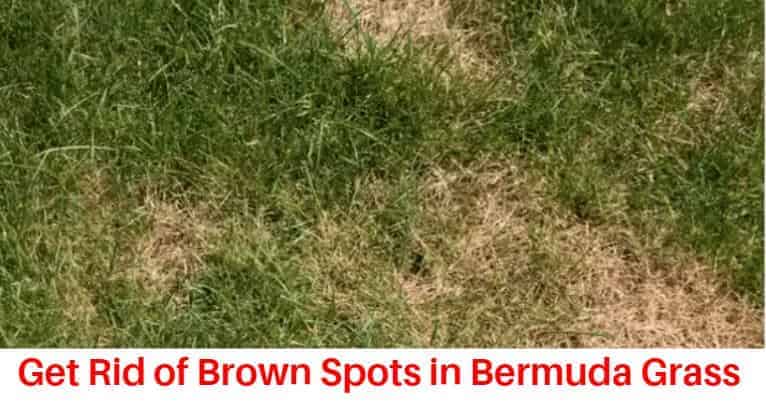
Before you get down to the part where you start to fix the brown patches, it is important to know the cause. This will help determine the right remedy to eliminate brown spots in your lawn.
Here are the various causes of the unwanted discoloration spots in your lawn:
1. Brown patch disease fungus
Let’s start with the most obvious of them all – lawn fungi! Whether it’s brown patch disease, spring dead spot, dollar spot, or leaf spot, fungi are a huge detriment to the health of turfgrass.
Most of these fungi stay dormant while waiting for the perfect conditions for growth and reproduction. The brown patches or dead spots will start to show during the warmth of the hot summer days and the moisture from the nighttime irrigation you perform on your grass lawn.
With time, fungal residue inhibits photosynthesis, and as the fungi gradually spread across the grass leaves, it leaves dead spots on the infested areas. The visual results are patches of brown grass. Learn more about brown patch disease and how it affects your lawn.
| Preview | Product | Rating | |
|---|---|---|---|

|
Scotts DiseaseEx Lawn Fungicide, Controls and Prevents Disease Up... | 12,695 Reviews | Check Latest Price |

|
BioAdvanced Fungus Control for Lawns, Ready-to-Spray, 32 oz | 5,511 Reviews | Check Latest Price |
Affiliate links and images pulled from the Amazon Product Advertising API on: 2024-04-18
2. Compaction
Dead grass patches in bermudagrass lawns may also appear if the ground beneath your turf is compacted. This is especially common for newly sodded lawns, whereby homeowners usually overlook the importance of plowing, aerating, and dethatching the lawn.
Such compact soil causes drainage issues during watering or rainfalls, resulting in waterlogging that causes root suffocation.
Root suffocation cuts off the supply of nutrients to the stem and the leaf blades, hence the brown color.
The brown color is a sign of your grass being starved of nutrients and oxygen. It could also mean your grass is dying in the areas with water-logging problems.
3. Shade
Heavily shaded areas in your lawn are also highly susceptible to dead grass spots, as Bermuda grass requires sufficient sunlight for photosynthesis. Too much shade exposes this grass variety to pests and diseases.
If you’ve got trees and other flora in your lawn, they may be cutting off the supply of sunlight to your grass.
Bermuda grass requires at least 4 hours of direct sunlight each day. Less than this amount of sunlight exposure causes the grass to photosynthesize less thus, reduces the amount of energy available to the plant and retards growth. In turn, Bermuda grass will suffer reduced tolerance to heat, cold, drought, and disease.
4. Bermuda grass dormancy
Bermuda grass is a warm-season grass. As such, it falls into a dormant stage during the cooler seasons, especially starting from late autumn.
During this dormancy period, your Bermuda grass turf will develop brown patches, which won’t disappear until the return of the warmer seasons.
In most places where Bermuda grass grows, active growth season starts from April to September. The dormancy period starts sometime in the fall when the temperatures drop below 55 degrees.
The growth season will start in the spring when temperatures start to rise above 55 degrees. Before that, if you notice brown spots during dormancy it will most likely be due to a fungus that has found its way in.
Find out more information on the causes of fungus in grass.
How to Fix Brown Spots in Bermuda Grass Lawns
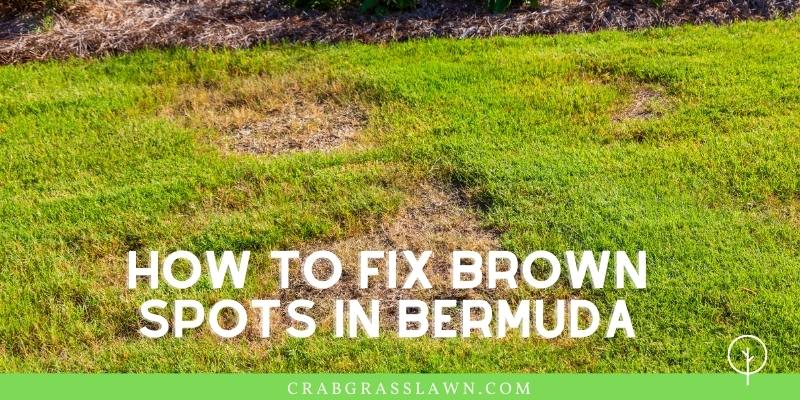
Before you start exploring the remedies for the brown spots in your lawn, it is important to pinpoint the exact cause first. Each of the causes discussed above has its fix.
Here’s how to get rid of brown spots in lawns:
1. Treat lawn fungi – brown patch disease
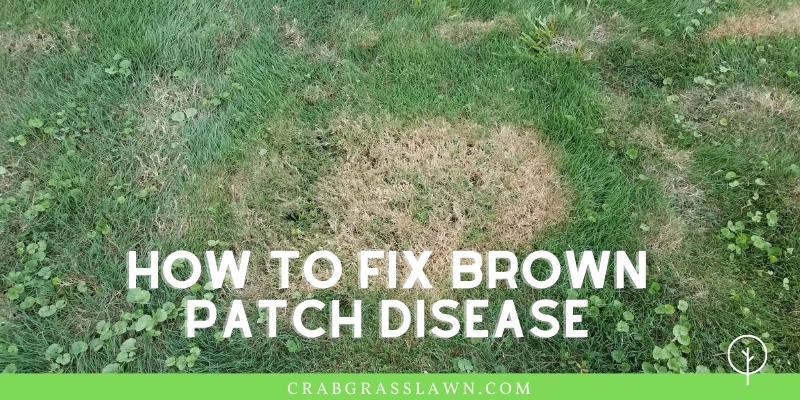
Since the cause of brown patch disease is facilitated by overnight moisture on warm days, it’s advisable to avoid nighttime irrigation during the summer.
The recommended practice would be to water your Bermuda grass lawn in the morning during warm days, giving your lawn enough time to dry off by sundown. This denies the fungi within your turf the moisture they need to reproduce.
Prune nearby plants to ensure sufficient airflow above your grass, thereby establishing a non-conducive environment for fungal growth.
Alternatively, you can apply anti-fungal pesticides/fungicides such as Southern AG Liquid Copper Fungicide.
- Controls diseases caused by bacteria and fungi
- New Formulation works well with hose end sprayers
- Labeled for control of moss and algae
Affiliate links and images pulled from the Amazon Product Advertising API on: 2024-04-18
The anti-fungal pesticide application schedule for treating brown patch disease over a standard-size (5000-square feet) lawn area – for instance – should be done every fortnight.
2. Aerate your lawn to reduce compaction

It’s advisable to plow the ground beneath the sod, as this oft-ignored practice helps relieve compaction.
Plowing can be done using a hollow tine tool (such as the Yard Butler Lawn Coring Aerator), which relieves compaction and facilitates turf aeration.
With a better flow of water and air to the roots, there’ll be better nutrient absorption and your Bermuda grass blades will regain their beautiful lush green appearance. Take note that while most lawns can benefit from aeration, it’s important to know how to perform the task and the best time of year.
3. Reduce Shade
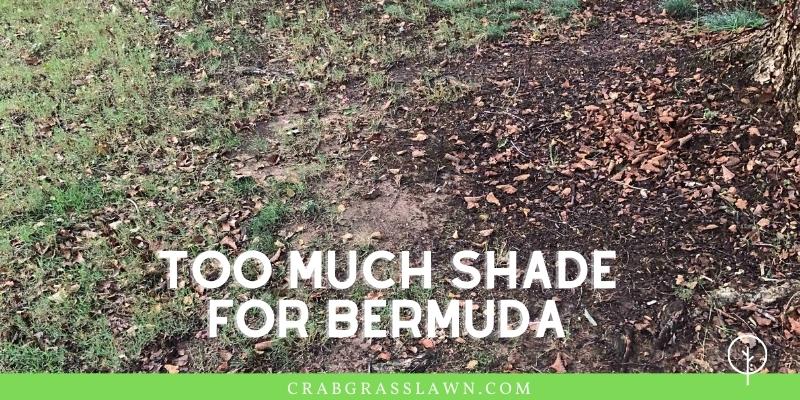
Ensure that the shrubs around your Bermuda grass lawn are periodically pruned for optimal sunlight penetration to your grass turf. Provide bermudagrass with at least 4 hours of direct sunlight per day to get rid of the brown spots in your lawn.
Besides, when mowing, it’s advisable to cut your Bermuda grass no lower than one-and-a-half inches to get rid of the brown patches. This ensures enough leaf surface area is left to facilitate photosynthesis, as a substantial length of every leaf blade will be exposed to direct sunlight. This helps eliminate shading stress.
4. Control pests to reduce brown spots
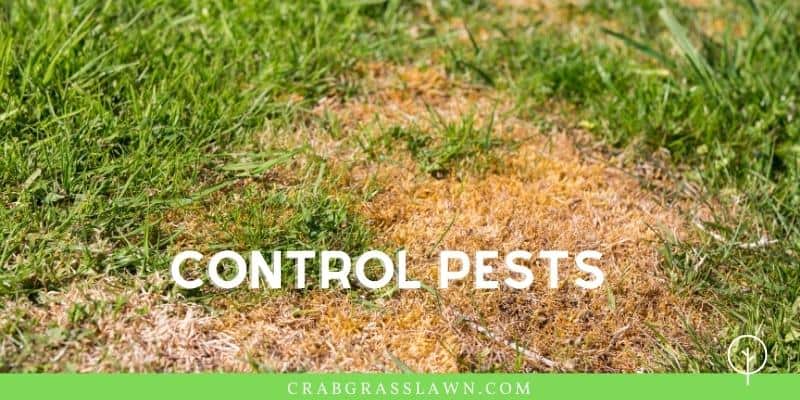
When the dead spots are caused by pests eating the roots of your grass, you’ll start to notice brown spots of dead grass. Grubworms are a common problem starting in spring. If you see these patches, check for lawn grub worms before you think it is Bermuda grass brown patch disease.
Grubs can be killed and prevented using a good grub control pesticide. However, if you keep incurring brown patches of dead grass every season, you may want to use a preventative measure.
The timing for grub control is important and should be done to perfection to prevent Bermuda grass dead spots in the subsequent seasons. Here’s a list of common lawn pests.
How to Prevent Brown Patches in Lawn
Here are some great tips to help you prevent brown patches in your lawn:
Overseed with a cool-season grass seed
One of the best ways to prevent brown patches in your lawn is by overseeding your Bermuda grass turf with cool-season grass seed. The cool-season grass variant won’t go dormant during fall and winter, thereby allowing your turf to retain its lush look even with the dormancy of the Bermuda grass.
Identify and treat lawn diseases
As earlier discussed, a positive ID of whichever fungal disease or issue is ailing your Bermuda grass is crucial in ensuring that you’re spending on fungus treatment measures that will work.
The sampling process for turfgrass disease determines whether your disease diagnosis is accurate or not.
The recommended sampling procedure is as outlined below:
- Pick one of the disease areas/ brown patchy spots.
- Determine the disease margin area, which is the borderline of live grass and dead grass.
- Dig out a four-by-four-inch square grass turf sample from the disease margin area. Half the sample should contain fresh grass, with the other half containing dead grass.
- Don’t cut out the roots.
- Keep the sample away from heat or anything that might dry it out fast.
- Take the sample to the local county extension office for a professional diagnosis. This should preferably be done as soon as possible to prevent drying of the sample.
- If you’re unable to take your Bermuda grass sample for diagnosis on the same day you’ve dug it out, it’s advisable to keep it under refrigeration. This will keep it from drying out as well.
Overall, you can maintain a great lawn free of brown spots and patches, or areas of thinning by feeding the grass properly, watering, and following the best practices when seeding and sodding.
Hi, Alex Kuritz here. Growing up I remember that my family had one of the best lawns in the neighborhood. Richly green and lush. I did a lot as I grew up in terms of caring and tending for not only my family’s lawn but also my neighbors. I can say I have years of experience, and I am here to share it with you.




I had some corners of my yard where the grass was sparse and a black layer developed in those spots. I’m assuming that was some type of fungus. Subsequently I re-sodded those corners. Now I have brown spots. Can I safely assume it’s caused by a fungus?
Hi Sue, yes I would say that there is some sort of fungus happening there. Best to do a soil test to know for sure. Or if the area is not that large you can dig out that dirt and replace with fresh dirt.